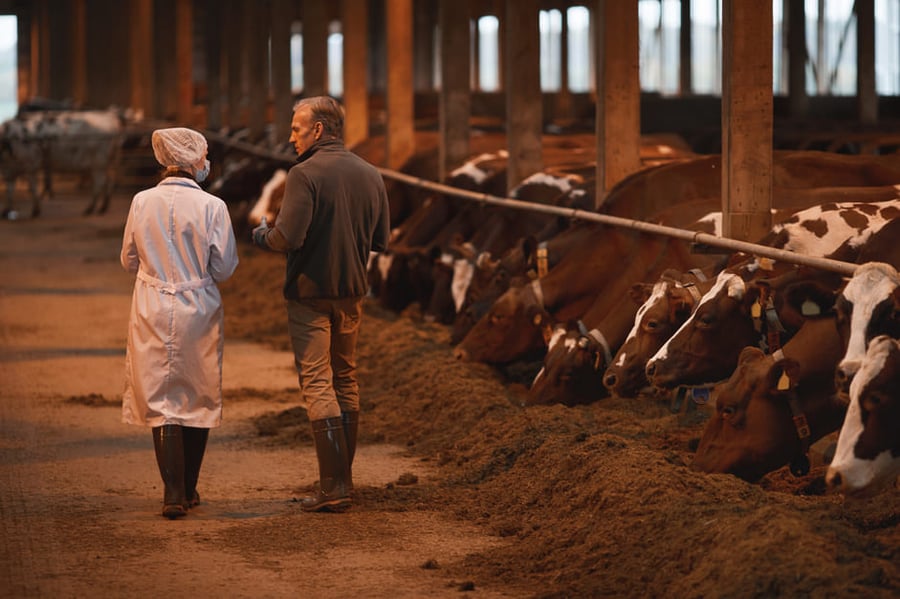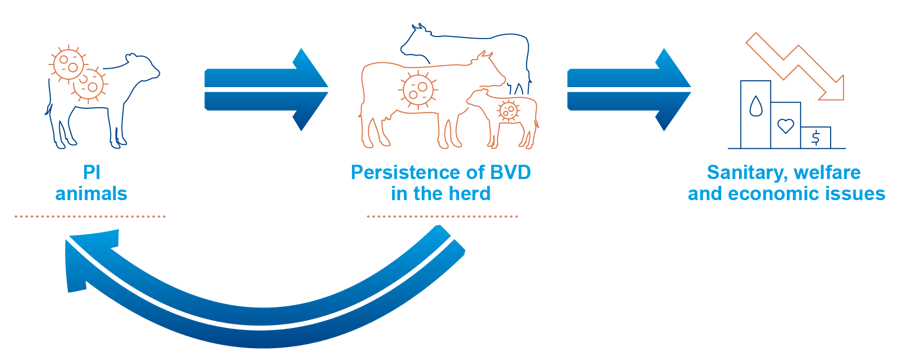Bovine Viral Diarrhea (BVD) is a disease responsible for major sanitary issues and economic losses in cattle. BVD virus can infect several tissues and cells and trigger various clinical signs. Indeed, in cattle, BVD can be involved in various clinical signs, such as:
- Respiratory disease
- Diarrhea
- Immunodeficiency which leads to an increased sensitivity to other infectious diseases
- Reproductive disorders such as abortions, embryo mortality, birth of malformed calves and infertility
What is a PI animal ?
In cattle, BVD virus can be found in two types of animals:
- Transient Viremic (TV). As the name suggests, these animals are temporarily infected by the virus but, thanks to their immune system, they can get rid of it within a few weeks (usually between 3 and 4 weeks after contamination).
- Persistently Infected (PI). These animals are contaminated by the virus in utero between 30 and 125 days of gestation. At this stage, their immune system is not yet effective and, therefore they don’t recognise the virus as a foreign organism. As a result, they remain infected for life. In other words, they never get rid of the virus.

- Directly from one animal to another, usually by muzzle-to-muzzle contact. This contamination can occur within a herd or between different herds with contact between animals “over the fence”.
- Indirectly through clothes or boots or when some equipment is shared between different farms, such as cattle trucks.
- From dam to calf in utero. In 100% of these cases, the calf will be a PI animal. This contamination happened in two cases:
- The dam is herself a PI animal.
- The dam becomes infected between the day 30 and the day 125 of pregnancy.

PI animals: the corner stone of BVD
It is of main importance to manage PI animals properly and to avoid, as most as possible, their birth. Indeed, they are persistently infected and they shed the virus in large amount during all their life. Thus, PI animals can contaminate many other cattle. BVD virus can therefore infect pregnant cows and if these latest are between 30 and 125 days of pregnancy they will give birth to a new PI animal.
Because of PI, BVD is a real vicious circle. A herd with PI animals suffers many sanitary and welfare problems as well as significant economics losses.
To summarize, PI animals
- Live with the virus
- Don’t have immunity against the virus
- Shed virus all their life, thus contaminate other animals

How to control BVD ?
The best way to control the disease is to get rid of PI animals by avoiding their birth. This is the combination of two methods which lead to the best results:
- Biosecurity measures: management of already known PI animals, control of new animal introduction in the herd, proper disinfection of shared equipment, avoid direct or indirect contact with animals from other herds, especially if their health status is unknown.
- Vaccination of cows before pregnancy with a cattle BVD vaccine having the fetal protection claim. This type of vaccine protects the fetus in utero against the disease. Even if the dam is contaminated during pregnancy, the fetus will remain safe.
BVD is one of the most, if not the most, important cattle disease in many countries. The persistence of the disease within a herd if directly related to PI animals. It is therefore crucial to identify them, manage them and avoid the birth of new PI calves. Taking appropriate measures will break the vicious circle of the disease and therefore improve the health and welfare of the animals as well as the profitability of the farm.
About the author
Philippe Gisbert (Ruminants Global Technical Manager)
Philippe Gisbert started his career in 1994 as a Vet practitioner working with companion and farm animals for over 9 years. He then became Health Affairs Manager for Group Agena (artificial insemination company). In 2008 he joined Eurofins – Laboratoire Coeur de France as Animal Health Unit Manager where he worked for 7 years until he joined Ceva France as Technical Manager Ruminants (Infectiology, Vaccines and Diagnostic). Since 2020 he is Global Technical Manager for Biologicals, Udder Health and Antiinflammatories. He is a member of SIMV diagnostic and anti-infective technical groups and has integrated different working groups of ANSES and UNCEIA related to epidemiology, antibiotic resistance and reproduction in livestock.
Explore author’s articles
%20(1)%20(1).webp)

Leave your comments here